Buttermilk is an essential ingredient in traditional soda breads so I decided to learn how to make a buttermilk plant. The acid in the buttermilk reacts with the baking soda and creates gases to make the bread rise. This reaction is very quick so be sure to have a hot oven ready and bake the bread right away before the gas dissipates.
Buttermilk can be cultured quite easily using a buttermilk plant. This version is adapted and updated from Florence Irwin’s 1949 recipe.
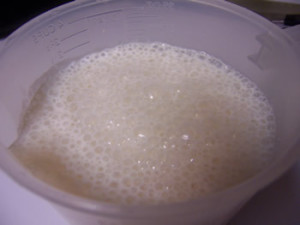
How to Make a Buttermilk Plant:
The Best of Irish Breads & Baking by Georgina Campbell
I started the buttermilk plant several days ago so the buttermilk would be ready to use in some Brown Soda Bread.
Ingredients:
- 3/4 pint/450 ml/2 cups skimmed milk
- 1/4 pint/150 ml/1/2 cup boiling water
- 1 oz/25g yeast
- 2 tsp/2 1/2 US tsp sugar
Directions:
Heat the milk to lukewarm by adding the boiling water. Then add the yeast and sugar. Pour into a sterilized screw-top jar, allowing enough head space for the contents to be shaken.
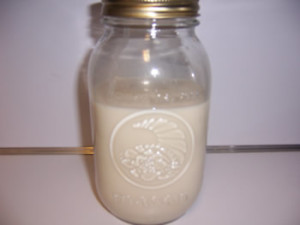
Place the jar on its side in a warm, dark place (a cupboard is perfect).

Shake several times a day for 4-6 days, depending on the temperature, while the buttermilk plant is forming.
I let it sit in the cabinet for several days and shook it a few times a day. It was a little cold and rainy this past week so it took about 6 days for it to culture.
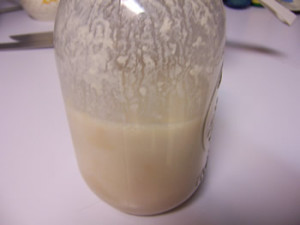
Here is the buttermilk plan resting in the cabinet after it has been shaken.
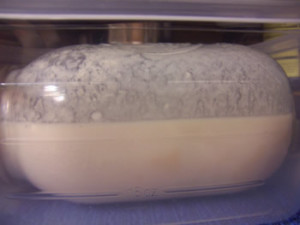
Then remove the jar and open it carefully to prevent it bubbling over.
I actually had that happen. The jar exploded in my cabinet and buttermilk ran all over the counter. So don’t do that! If you look closely at the photo above, you will notice that I placed the jar inside a plastic container so if it exploded again, it wouldn’t get all over everything.
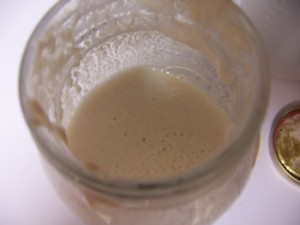
Strain the contents into a jug — the cultured sour milk in the jug is used as buttermilk. You can see bits of yeast in the strainer.
The lumpy bits of yeast left in the strainer can be washed and re-used indefinitely. As the plant grows, it can be divided to share with others.
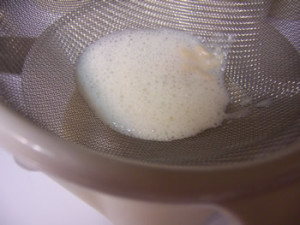
Here is the strained buttermilk. Now it can be used in a recipe.

I used a jar that I had washed and sterilized to store the buttermilk. Then I put it in the refrigerator for a few days.
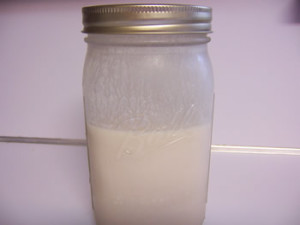
To re-use the buttermilk plant:
Pour lukewarm water through the bits left in the strainer and wash off all remaining milk. Return the yeast (the buttermilk plant) to the washed and scalded jar, adding lukewarm milk and water as before. Repeat the ripening process, straining again after about 4 days (maybe 2 days in summer) when it is sour and thick.
At the end of each day, any leftover milk can be added to the jar if there is room.
Always wash all the old milk from the yeast and make sure that the jar is properly sterilized before starting another brew.
Alternatives:
- Although the results are not quite the same, yogurt is sometimes mixed with sweet (fresh) milk and works in a way which is similar to buttermilk.
- Cream of tarter can be added to the dry ingredients to provide the acid.
- Sweet milk can be soured by adding lemon juice.
I hope you enjoyed learning how to make the buttermilk plant.
Happy Baking!
Cathy
Michelle says
This is similar to a sourdough starter except you used milk instead of water.
What a great idea and one I’ve not heard of before. I’ll have to try it. What I need is another qt jar of stuff in the frig..LOL!
Cathy (breadexperience) says
This was an interesting experiment to say the least.